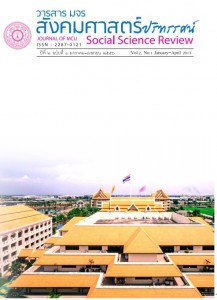ศึกษาผลสัมฤทธิ์การเผยแผ่พระพุทธศาสนาในกลุ่มชาติพันธุลีซูของพระธรรมจาริก
บทคัดย่อ
การวิจัยเรื่อง "ผลสัมฤทธิ์การเผยแผ่พระพุทธศาสนาในกลุ่มชาติพันธุลีซู ของพระธรรมจาริก" มีวัตถุประสค์ ๓ ประการคือ ๑. เพื่อศึกษาสภาพการเยแผ่พระพุทธศาสนาของพระธรรมจาริก ในกลุ่มชาติพันธุลีชู ๒. เพื่อศึกษปัญหอุปสรรคต่อผลสำเร็การเผยแผ่พระพุทธศาสนาชองพระธรรมจาริก
ในกลุ่มชาติพันธุลีซู และ ๓ เพื่อแสวหาแนวหงที่เหมาะสมในการผยแผ่พระพุทรศสนาของพระธรรมจาริก ในกลุ่มชาติพันธุลีซู ระเบีบวิธีวิจัยที่ใช้ในกรศึกษา เป็นการวิจัยเชิคุณภาพ และผสมด้วยการวิจัยภาคสนาม สำรวจความคิดเห็นจากพื้นที่ริง ดัวยเครื่องมืวิจัยแบบสัมภาษณ์เชิงลึก และการประชุมกลุ่มย่อย ประชากรและกลุ่มป้หมายที่ใช้ศึกษา เป็นกลุ่มชาติพันธุลีชู ๒ หมู่บ้าน คือ บ้านเลาวู และบ้านศรีคงเย็น (บ้านตันลุง) ที่พระรรมจาริกไปผยแผ่พระพุทธศาสนา, ชนชาติพันธุลีชูผู้ที่เคยบรรพชา-อุปสมบท ผู้ที่เคยศึกษาเล่เรียนที่วัดศรีโดา, พระธรรมจาริกที่เข้าไปเผยแผ่พระพุทธศาสนากับชาวลีซู และ เจ้าหน้าที่พัฒนสัดมและความมั่นคงของมนุษย์ (ประชาสงเคราะห์ชาวเขา) ผู้มีความรู้ความ เชี่ยวชาญค้นชาติพันธุลีชู จำนวน ๖๓ รูป/คน การวิเคราะห์ ใช้วิธีวิเคราะห์เนื้อหากับข้อมูลเอกสาร ส่วนข้อมูลจากแบบสัมภาษณ์เชิงลึก และการประชุมกลุ่ม วิเคราะห์ด้วยสถิติความถี่ ค่าร้อยละ ค่เฉลี่ยกลาง ค่าเบี่ยงเนมาตรฐาน และสรุปความเห็นเนื้อหาที่เกี่ยวข้อง นำเสนอในแบบพรรณนา เชิงวิเคราะห์ และตารางประกอบคำบรรยาย
ผลของการศึกษาวิจัยพบว่า
๑) สภาพการเผยแผ่พระพุทรศสนาของพระธรมจาริกในกลุ่มชาติพันธุลีซู นั้น เป็นไป ด้วยความเชื่องช้ มีความยกลำบากกว่าการเผยแผ่ในกลุ่มชาติพันธุ์อื่น พระธรรมจาริกได้ตั้งอาศรม แห่แรกขึ้นที่บ้านลาว อำเภอวียงแหง และอาศรมแห่ที่ 6 ที่บ้านศรีคงเย็น (บ้านตันลุงหรือบ้านปาง
ไม้แดง) อำเภอแม่แตง สภาพการผยแพระพุทธศาสนาประสบความสำเร็จในระดับหนึ่ง โดยมีชาวลีซูได้ นับถือพระพุทธศาสนาและส่งบุตรหลานข้ามาบวชเรียน แต่ก็ยังมีจำนวนไม่มากนัก ทั้งนี้เป็นเพราะกลุ่ม ชาติพันธุลีชู มีความเชื่ดั้งเดิมในลัทธิผีสางเทวดา เคารพนับถือบรรพบุรุษ อุปนิสัย อัตลักษณ์ของ ชนเผ่าลีชูตลอดจนวัฒนรรมของชาวลีชู ต่งจากศาสนาพุทธมาก อุดมคติ ของชาวลีชูก็ต่างจาก หลักการของพระพุทธศาสนาด้วย จึทำให้การเผยแผ่พระพุทธศาสนาของพระธรรมจาริก ไม่ประสบผลสำเร็จเท่าที่ควร
๒) ปัญหาอุปสรรคตการเผแพระพุทรศสนาของพระธรรมจาริก ในกลุ่มชาติพันธุ์ลีซู มีหลายประการ เช่น ก สภาพภูมิศาสตร์ การคมนาคม ยังไม่สะดวก ทุรกันดาร ลีชูบางหมู่บ้าน ยังไม่มีไฟฟ้าใช้ ต้องจุดตะเกียงน้ำมันหรืตะเกียงเจ้าพายุ หรือใช้วัสดุอื่นๆ เช่น ด้ายหรือไม้สน เกี้ยะจุดให้แสงสว่างกลางคืน ข. คติความเชื่และวัฒนธรรมตั้งเดิม ซึ่งลัทธิความเชื่อ ผีสาง เทวดา ของชาวลีชูบางหมู่บ้านยังมั่นคงไม่ปลี่ยนแปลง ปัญหาค้นคติชีวิตและค่นิยมเดิมก็เป็นอุปสรรค ซึ่งชาวลีชูมีภาษิตว่ "ทุกคนหัวเเทกัน" เป็นต้น ค. ภาษาที่สื่อสาร ชาวลีชูโดยมาก ยังไม่สันทัดใน การ พูดอ่น เซียน ภาษาไทย และโดยเฉพาะ "ภาษาลีชู" เอง ก็เป็นอุปสรรคสำหรับพระธรรมจาริก ที่ม่ใช่ชาวลีชูแล้วข้าไปผแผ่และอยู่ในหมู่บ้านลีชู และ ง. ปัญหาด้านบุคคลากร ได้แก่การ ขาดแคลนพระรรมจาริก หรืไม่มีพระธรมจาริกไปประจำอยู่ในหมู่บ้านลีซู ปัจจุบัน มีพระธรรม จาริก เพียง ๑ หรือ ๒ รูป ไปอยู่ในหมู่บ้านลีชู ๒ หรือ ๓ หมู่บ้านเท่านั้น
๓) แนวทางที่เหมาะสมในการผยแผ่พระพุทธศาสนาของพระธรรมจาริกในกลุ่ม ชาติพันธุลีซู พระรรมจาริก ควรมีการวางแผนเชิรุก นั่นคือ 0) ควรมีแผนการหรือโครงการเผยแผ่ พระพุทธศาสนาเป็นกรณีพิศษสำหรับชาวลีชู ๒) ควรชักชวนชาวลีซูหันมาเรียนพระปริยัติธรรมและ นักธรรมให้มากขึ้น ๓) ควรให้ทุการศึกษาแก่พระภิกษุสมณรชาวลีชที่ศึษาพระปริยัติธรรมและ นักธรรมอย่างต่อเนื่อง ๔ ควรกำหนดป้หมายว่ แต่ละปีจะอบรมแกนนำชาวพุทธลีชูกี่คน โดยการ เปิดรับอสามัครแกนนำขาพุทที่เป็นชาวลีซู ทั้งชายและหญิงแล้วนำมาอบรม ทำหน้าที่ช่วยพระธรรมจาริก ในการเผยแผ่พระพุทธศาสนา สำหรับการสอนหลักพระพุทธศาสนานั้น พระธรรมจาริกควรเน้น หลักพุทธธรรมที่ สำคัญและจำเป็นต่อการดำเนินชีวิต ช่น ศีล ๕ สังคหวัตถุ ๔ ฆรวาสธรรม ๔ อริยสัจ ๔ และ มรรคมืองค์ เพื่อปรับเปลี่ยนทัศนคติและวิสัยทัศน์ของกลุ่มชาติพันธุลีซูไห้ตรงตามหลัก พระพุทธศาสนาอย่างแท้จริง ซึ่งจะทำให้การผยแผ่พระพุทธศาสนาได้ผลยิ่งขึ้น
เอกสารอ้างอิง
๑..ภาษาไทย
ก. ข้อมูลปฐมภูมิ
มหาจุฬาลงกรณราชวิทยลัย. พระไตรปิฎกภาษาบาลี ฉบับมหาจุฬาเตปิฎก ๒๕๐๐. กรุงเทพมหานคร :โรงพิมพ์มหาจุฬาลงกรณ
ราชวิทยาลัย, ๒๕๓๕.
พระไตรปิฎกภาษไทย ฉบับมหาจุฬาลงกรณราชวิทยาลัย ๒๕๐๐. กรุงเทพมหานคร : โรงพิมพ์มหาจุฬาลงกรณราช
วิทยาลัย, ๒๕๓๙.
ข. ข้อมูลทุติยภูมิ
(๑) หนังสือ :
กรมพัฒนาสังคมและสวัสดิการ กระทรวงการพัฒนาสัดมและความมั่นคงของมนุษย์. ทำเนียบชุมชนบนพื้นที่สูง ๒๐ จังหวัดในประเทศไทย พุทธศักราช ๒๕๔๕. กรุงเทพมหานคร : บริษัทเนติกุลการพิมพ์ (๒๕๔๑) จำกัด, ๒๕๔๕.
คู่มือพระรรมจาริก. สำนักงานบริหารโครงการพระธรรมจาริก. ส่วนภูมิภาค วัดศรีโสดา เชียงใหม่,๒๕๓๗.
ปรุต บุญศรีตัน ผศดร. "หลักพระพุทธศาสนา" . เชียงใหม่. สำนักพิมพ์มรดกล้านนา, ๒๕๕o.
ประวิทย์ ตันตลานุกล. ประวัติวัดศรีโสดา. พิมพ์ครั้งที่ ด เชียงใหม่ : โรงพิมพ์แสงศิลป์, ๒๕๓๕.
ประเสริฐ ชัยพิกุสิต. สิบสองชนผ่ในประเทศไทย. เชียงใหม่ : โรงพิมพ์ปู - เป้, ๒๕๔o.
พระรรมโกศจารย์ (ประยูร ธมมจิตโต) การเผยแผ่เชิงรุก. กรุงเทพมหานคร : โรงพิมพ์มหาจุฬาลงกรณราชวิทยาลัย, ๒๕๔๘.
พระธรรมปิฎก (ป.อ. ประยุตโต). พุทธศาสนากับการศึกษไทยในอดีต. กรุงเทพมหานคร : โรงพิมพ์มหาจุฬาลงกรณราชวิทยาลัย, ๒๕๓๓.
พิสิฏ โคตรสุโพธิ์และพระหานกพันธ์ (ปภสสร) รูปแบบการจัดการศึกษาและการผยแผ่ศาสนธรรม :กรณีศึกษาวัตศโสดา. กรุงเทพมหานคร : สำนักงานเลขาธิการสภาการศึกษาแห่งชาติ,๒๕๕๖.
พุทธทาสภิกขุ. ใครนำพุทรศสนามาให้เรา. สมุทรปราการ : โรงพิมพ์ บี.พี. (สำโรง) การพิมพ์,๒๕๓๓.
สำนักงานบริหางนโดรงการพระธรรมจริกส่วนภูมิภควัดศรีโสดา. คู่มือพระธรรมจาริก : คู่มือ
สร้างสรรค์ความดีสู่สังคมคุณธรม. เชียงใหม่ : บุณย์ศิริงานพิมพ์, ๒๕๕๑
สยาม ราชวัตร. "หลักพระพุทธศาสน." เชียงใหม่. ห้างหุ้นส่วน พ.พร พิพัฒน์การพิมพ์, ๒๕๔๘.
(๒) วิทยานิพนธ์ :
จำรัส กันทะวงษ์. "ศึกษาเปรียบเทียบการเผยแผ่ศสนาพุทธและศาสนาคริสต์ในกลุ่มชาวเขา :ศึกษาเฉพาะกรณีชาวขาผ่ากะเหรียบ้านผาเต๊ะ ตำบลพระธาตุผาแดง อำเภอแม่สอดจังหวัดตาก".วิทยานิพนธ์อักษรศาสตมหาบัณฑิต. บัณฑิตวิทยลัย: มหาวิทยาลัยมหิดล, ๒๕๓๑.
บัณฑิต บุญศรี. "พระธรรมจริกกับการสร้างจิตสำนึกความเป็นไทยของชาวเขา" วิทยานิพนธ์ศิลปศาสตรมหาบัณฑิต. บัณฑิตวิทยาลัย มหาวิทยาลัยเชียงใหม่, ๒๕c๙.
ประจวบ ประเสริฐสัข์ "ปีจจัยที่มีผลต่อการปฏิบัติงนของพระธรรมจาริก : ศึกษาเฉพาะกรณี พระธรรมจาริกที่ปฏิบัติงานในจังหวัดเชียงใหม". วิทยานิพนธ์ศิลปศาสตรมหาบัณฑิต. บัณฑิตวิทยาลัย : มหาวิทยาลัยธรรมศาสตร์, ๒๕๓๙.
ประเสริฐ ชัยพิกุสิต "กระบวนการมีส่วนร่วมของชาวเขาในการผยแผ่พระพุทธศาสนาของพระธรรมจาริกในหมู่บ้านห้วยปง อำเภอเชียงดาว จังหวัดเชียงใหม". วิทยานิพนธ์พุทธศาสตรมหาบัณฑิต. บัณฑิตวิทยาลัย : มหาวิทยาลัยมหาจุฬาลงกรณราชวิทยาลัย, ๒๕๕๓.
พระฐนี ตวิริโย (จองเจน). การพัฒนาขีดความสามารถของพระสงฆ์เพื่อหนุนเสริมการแก้ไขปัญหาความยากจน วิทยานิพนธ์บริหารศาสตรตุษฎีบัณฑิต. บัณฑิตวิทยาลัย : มหาวิทยาลัยแมโจ้,๒๕๕๒.
มาลียา วงศ์รัตนมัจฉา. "การยอมรับบทบาททางการเมืองของผู้นำสตรีลีซอในหมู่บ้านลีซอแม่แตะ ตำบลเมืองแหง อำเภอเวียงแหง จังหวัดเชียงใหม". วิทยานิพนธ์รัฐศาสตรมหาบัณฑิต.บัณฑิตวิทยาลัย : มหาวิทยาลัยเชียงใหม่, ๒๕๔๗.
(๓) เอกสารที่ไม่ได้ตีพิมพ์
โครงการพระธรรมจาริกส่วนภูมิภาค วัดศรีโสดา จังหวัดเชียงใหม่, สรุปผลการดำเนินงานโครงการ พระธรรมจาริก. สำนักงานบริหารโครงการพระธรรมจาริกส่วนภูมิภาค, ๒๕๔๗. (อัดสำเนา)
สำนักทะเบียนกลาง, ระเบียบสำนักทะเบียนกลางว่ด้วยการพิจรณาลงรายการสถานะบุคคลใน ทะเบียนราษฎรให้แบคคลบนพื้นที่สูง ผศ. ๒๕๘ด. กระทรวงมหาดไทย, ๒๕๔๓. (อัดสำเนา)
ศรีวงษ์ เจริญวงศ์ ๗ ปี วัดศรีโสดา ๔๐ ปี พระรรมจาริก. แผ่นพับ เนื้อหาเกี่ยวกับ ประวัติความเป็นมาของวัดศรีโสดา ตำบลสุเทพ อำเภอเมือง จังหวัดเชียงใหม่และการเผยแผ่ พระรรมจาริกในพระพุทธศาสนาต่ชนชาติพันธุลีชูบ้านนาเลาและบ้านขุนคอง(เลาว) อำเภอเชียงดาว จังหวัดเซียงใหม่, ๒๕๔๘ะ. (อัดสำเนา)
ดาวน์โหลด
เผยแพร่แล้ว
รูปแบบการอ้างอิง
ฉบับ
ประเภทบทความ
สัญญาอนุญาต
ลิขสิทธิ์ (c) 2018 วารสาร มจร สังคมศาสตร์ปริทรรศน์

อนุญาตภายใต้เงื่อนไข Creative Commons Attribution-NonCommercial-NoDerivatives 4.0 International License.
เพื่อให้เป็นไปตามกฎหมายลิขสิทธิ์ ผู้นิพนธ์ทุกท่านต้องลงลายมือชื่อในแบบฟอร์มใบมอบลิขสิทธิ์บทความให้แก่วารสารฯ พร้อมกับบทความต้นฉบับที่ได้แก้ไขครั้งสุดท้าย นอกจากนี้ ผู้นิพนธ์ทุกท่านต้องยืนยันว่าบทความต้นฉบับที่ส่งมาตีพิมพ์นั้น ได้ส่งมาตีพิมพ์เฉพาะในวารสาร มจร สังคมศาสตร์ปริทรรศน์ เพียงแห่งเดียวเท่านั้น หากมีการใช้ภาพหรือตารางหรือเนื้อหาอื่นๆ ของผู้นิพนธ์อื่นที่ปรากฏในสิ่งตีพิมพ์อื่นมาแล้ว ผู้นิพนธ์ต้องขออนุญาตเจ้าของลิขสิทธิ์ก่อน พร้อมทั้งแสดงหนังสือที่ได้รับการยินยอมต่อบรรณาธิการ ก่อนที่บทความจะได้รับการตีพิมพ์ หากไม่เป็นไปตามข้อกำหนดเบื้องต้น ทางวารสารจะถอดบทความของท่านออกโดยไม่มีข้อยกเว้นใดๆ ทั้งสิ้น





